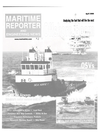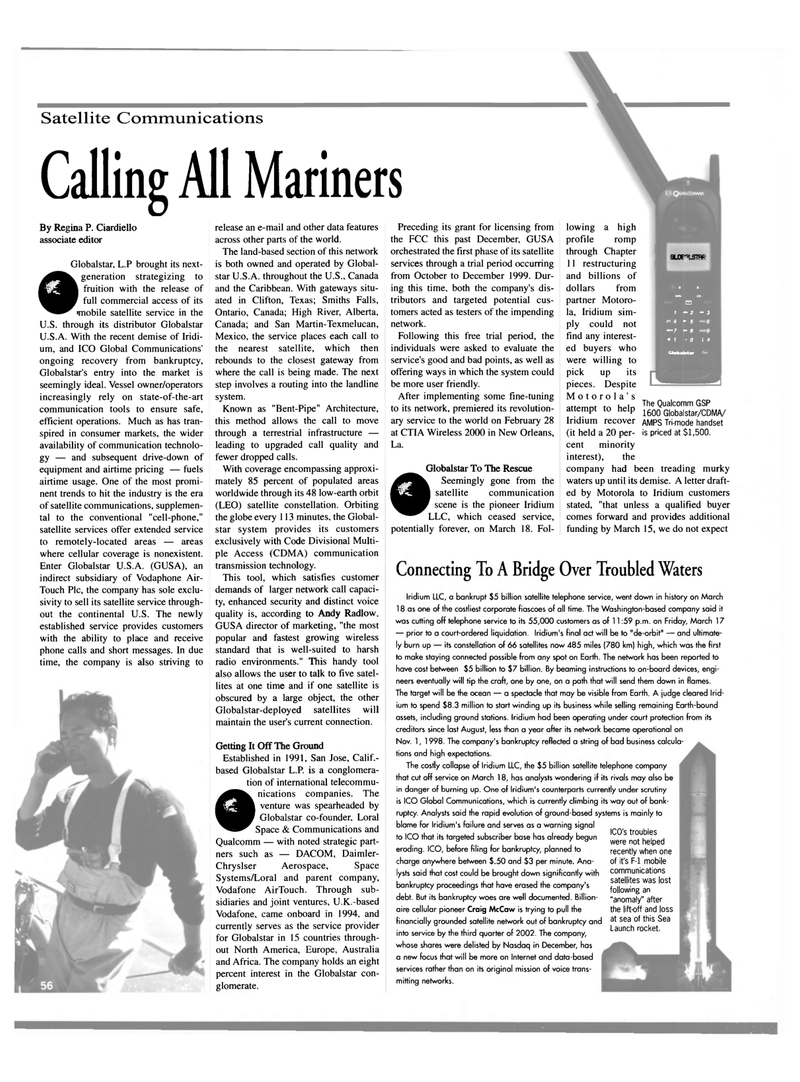
Page 60: of Maritime Reporter Magazine (April 2000)
Read this page in Pdf, Flash or Html5 edition of April 2000 Maritime Reporter Magazine
Satellite Communications
Calling All Mariners
By Regina P. Ciardiello associate editor
Globalstar, L.P brought its next-® generation strategizing to fruition with the release of full commercial access of its mobile satellite service in the
U.S. through its distributor Globalstar
U.S.A. With the recent demise of Iridi- um, and ICO Global Communications' ongoing recovery from bankruptcy,
Globalstar's entry into the market is seemingly ideal. Vessel owner/operators increasingly rely on state-of-the-art communication tools to ensure safe, efficient operations. Much as has tran- spired in consumer markets, the wider availability of communication technolo- gy — and subsequent drive-down of equipment and airtime pricing — fuels airtime usage. One of the most promi- nent trends to hit the industry is the era of satellite communications, supplemen- tal to the conventional "cell-phone," satellite services offer extended service to remotely-located areas — areas where cellular coverage is nonexistent.
Enter Globalstar U.S.A. (GUSA), an indirect subsidiary of Vodaphone Air-
Touch Pic, the company has sole exclu- sivity to sell its satellite service through- out the continental U.S. The newly established service provides customers with the ability to place and receive phone calls and short messages. In due time, the company is also striving to release an e-mail and other data features across other parts of the world.
The land-based section of this network is both owned and operated by Global- star U.S.A. throughout the U.S., Canada and the Caribbean. With gateways situ- ated in Clifton, Texas; Smiths Falls,
Ontario, Canada; High River, Alberta,
Canada; and San Martin-Texmelucan,
Mexico, the service places each call to the nearest satellite, which then rebounds to the closest gateway from where the call is being made. The next step involves a routing into the landline system.
Known as "Bent-Pipe" Architecture, this method allows the call to move through a terrestrial infrastructure — leading to upgraded call quality and fewer dropped calls.
With coverage encompassing approxi- mately 85 percent of populated areas worldwide through its 48 low-earth orbit (LEO) satellite constellation. Orbiting the globe every 113 minutes, the Global- star system provides its customers exclusively with Code Divisional Multi- ple Access (CDMA) communication transmission technology.
This tool, which satisfies customer demands of larger network call capaci- ty, enhanced security and distinct voice quality is, according to Andy Radlow.
GUSA director of marketing, "the most popular and fastest growing wireless standard that is well-suited to harsh radio environments." This handy tool also allows the user to talk to five satel- lites at one time and if one satellite is obscured by a large object, the other
Globalstar-deployed satellites will maintain the user's current connection.
Getting It Off The Ground
Established in 1991, San Jose, Calif. - based Globalstar L.P. is a conglomera- tion of international telecommu- • nications companies. The venture was spearheaded by
Globalstar co-founder, Loral
Space & Communications and
Qualcomm — with noted strategic part- ners such as — DACOM, Daimler-
Chryslser Aerospace, Space
Systems/Loral and parent company,
Vodafone AirTouch. Through sub- sidiaries and joint ventures, U.K.-based
Vodafone, came onboard in 1994, and currently serves as the service provider for Globalstar in 15 countries through- out North America, Europe, Australia and Africa. The company holds an eight percent interest in the Globalstar con- glomerate.
Preceding its grant for licensing from the FCC this past December, GUSA orchestrated the first phase of its satellite services through a trial period occurring from October to December 1999. Dur- ing this time, both the company's dis- tributors and targeted potential cus- tomers acted as testers of the impending network.
Following this free trial period, the individuals were asked to evaluate the service's good and bad points, as well as offering ways in which the system could be more user friendly.
After implementing some fine-tuning to its network, premiered its revolution- ary service to the world on February 28 at CTIA Wireless 2000 in New Orleans,
La.
Globalstar To The Rescue ®
Seemingly gone from the satellite communication scene is the pioneer Iridium l,LC, which ceased service, potentially forever, on March 18. Fol- mrwrn lowing a high profile romp through Chapter 11 restructuring and billions of dollars from partner Motoro- la, Iridium sim- ply could not find any interest- ed buyers who were willing to pick up its pieces. Despite
Motorola's attempt to help
Iridium recover (it held a 20 per- cent minority interest), the company had been treading murky waters up until its demise. A letter draft- ed by Motorola to Iridium customers stated, "that unless a qualified buyer comes forward and provides additional funding by March 15, we do not expect
A A
M> Or a 1 — 2 - 3 " 5 ""7 8 • J • 0 1 #
CMikU,
L ^
The Qualcomm GSP 1600 Globalstar/CDMA/
AMPS Tri-mode handset is priced at $1,500.
Connecting To A Bridge Over Troubled Waters
Iridium LLC, a bankrupt $5 billion satellite telephone service, went down in history on March 18 as one of the costliest corporate fiascoes of all time. The Washington-based company said it was cutting off telephone service to its 55,000 customers as of 11:59 p.m. on Friday, March 17 — prior to a court-ordered liquidation. Iridium's final act will be to "de-orbit" — and ultimate- ly burn up — its constellation of 66 satellites now 485 miles (780 km) high, which was the first to make staying connected possible from any spot on Earth. The network has been reported to have cost between $5 billion to $7 billion. By beaming instructions to on-board devices, engi- neers eventually will tip the craft, one by one, on a path that will send them down in flames.
The target will be the ocean — a spectacle that may be visible from Earth. A judge cleared Irid- ium to spend $8.3 million to start winding up its business while selling remaining Earth-bound assets, including ground stations. Iridium had been operating under court protection from its creditors since last August, less than a year after its network became operational on
Nov. 1, 1998. The company's bankruptcy reflected a string of bad business calcula- tions and high expectations.
The costly collapse of Iridium LLC, the $5 billion satellite telephone company that cut off service on March 18, has analysts wondering if its rivals may also be in danger of burning up. One of Iridium's counterparts currently under scrutiny is ICO Global Communications, which is currently climbing its way out of bank- ruptcy. Analysts said the rapid evolution of ground-based systems is mainly to blame for Iridium's failure and serves as a warning signal to ICO that its targeted subscriber base has already begun eroding. ICO, before filing for bankruptcy, planned to charge anywhere between $.50 and $3 per minute. Ana- lysts said that cost could be brought down significantly with bankruptcy proceedings that have erased the company's debt. But its bankruptcy woes are well documented. Billion- aire cellular pioneer Craig McCaw is trying to pull the financially grounded satellite network out of bankruptcy and into service by the third quarter of 2002. The company, whose shares were delisted by Nasdaq in December, has a new focus that will be more on Internet and data-based services rather than on its original mission of voice trans- mitting networks.
ICO's troubles were not helped recently when one of it's F-l mobile communications satellites was lost following an "anomaly" after the lift-off and loss at sea of this Sea
Launch rocket.

 59
59

 61
61
